It's also commonly known as "royal tteokbokki" or "court tteokbokki" today because there are historical records that explain how people in the royal court enjoyed a dish made with steamed white rice cake, sesame oil, soy sauce, green onions, mushrooms, pine nuts and sesame salt, during late Joseon times. In the past, the dish went by a variety of names -- tteokjjim, tteokjapchae or tteok jeongol -- instead of simply tteokjjim.
Tteokbokki, rice cake seasoned with a spicy chili sauce, is considered one of the most popular street foods and snack items in Korea today. In fact, however, traditionally it was not a spicy dish in the beginning. Enjoyed at the royal court in the past, this dish was made with steamed white rice cake, beef, mushrooms and various vegetables, all seasoned with some soy sauce. It pleases both the palate and the eyes, as the ingredients come together in colorful harmony: yellow and white from the fried egg whites and yolks, the onion, red from the peppers and carrots, black from the shitake mushrooms, and green from the bell pepper. The dish also gives diners a variety of nutrients.
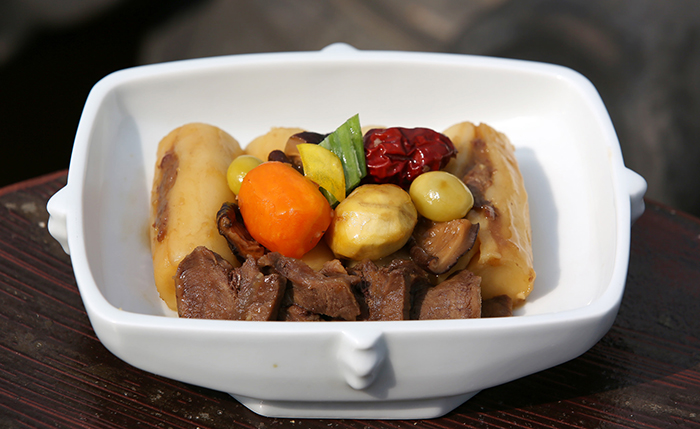
Tteokjjim is made from steamed white rice cake stuffed with beef and vegetables, and then seasoned with soy sauce. In Joseon times, court ladies used to cook the dish for the monarch himself, as it helped with the digestion without putting a burden on the stomach, even though it was a meat dish.
This commonly available tteokbokki, seasoned with a spicy pepper sauce, first appeared in the 1950s. The dish began to win popularity in the 1970s when it was first introduced as a snack food for the common people. At the time, steamed rice cake made from flour was mostly used because rice cake was particularly expensive. The dish has gone on to become one of the most popular snacks in the country, along with fish cake skewers, or eomuk, too.
** Ingredients
300 grams of white rice cake
Oil marinade:
1/2 teaspoon of soy sauce (3 grams)
1/2 teaspoon of sesame oil (4 grams)
40 grams of chopped beef (rump)
Marinade 1:
1 teaspoon of soy sauce (6 grams)
1/2 teaspoon of sugar (2 grams)
1/2 teaspoon of chopped green onions (2.3 grams)
1/4 teaspoon of minced garlic (1.4 grams)
1/2 teaspoon of sesame salt (1 gram)
0.1 gram of ground pepper
1 teaspoon of sesame oil (4 grams)
60 grams of carrots
2 cups of water (400 grams)
1/4 teaspoon of salt (1 gram)
1 shitake mushroom (5 gram)
4 chestnuts (60 grams)
4 jujubes (16 grams)
12 ginkgo nuts (24 grams)
1 teaspoon of pine nuts (3.5 grams)
Marinade 2:
1/2 tablespoon of soy sauce (27 grams)
1 tablespoon of sugar (12 grams)
1/2 tablespoon of chopped green onions (7 grams)
1 teaspoon of minced garlic (5.5 grams)
1 teaspoon of sesame salt (2 grams)
1/2 tablespoon of sesame oil (6.5 grams)
1 egg (60 grams)
20 grams of water parsley
1/2 tablespoon of flour (3.5 grams)
1 tablespoon of cooking oil (13 grams)
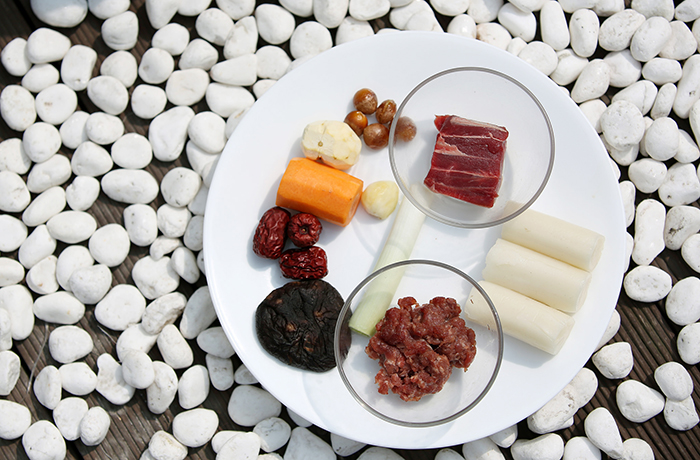
The ingredients for tteokjjim include white rice cake, beef, carrots, chestnuts, jujubes, mushrooms, ginkgo nuts and pine nuts.
** Preparation
1. Cut the white rice cake into 6-centimeter long strips. Make cuts in four sides of the cakes while leaving 1 centimeter on each of the two ends. Apply the oil marinade to the rice cake.
2. Clean the blood off the beef and mince the meat. Add half of marinade 1 to the chopped meat.
3. Trim the carrots and wash them clean. Cut the carrots into stumps 2.5 centimeters long and trim the edges. Soak the mushroom in water for 1 hour. Cut the mushroom and remove its stem. Remove any water from the mushroom and cut it into two or four pieces.
4. Peel the chestnuts and wipe the jujubes with a cotton cloth. Heat the frying pan with cooking oil and cook the ginkgo nuts over a medium heat for 2 minutes. Peel the cooked ginkgo nuts. Remove the tops of the pine nuts. Wipe the nuts with a cotton cloth.
5. Make marinade 2.
6. Fry the egg whites and the yolks separately. Make pancakes with the water parsley and cut it diagonally into 2-centimeter long pieces.
** Recipe
1. Stuff the rice cake with chopped beef.
2. Put the beef and water into a pot and boil it over high for 4 minutes. When it comes to a boil, lower the heat to medium and cook it for 30 minutes. Remove the beef from the pot and cut the meat into pieces that are 2 centimeters long horizontally, 3 centimeters long vertically and 0.3 centimeters wide. Add the remainder of marinade 1 to the beef. Chill the boiled water and drain it on a cotton cloth to make a broth.
3. Put the beef, carrots, shitake mushroom and chestnuts in a pot with the broth and half of marinade 2. Boil it all together over high for 5 minutes. Add the rice cake, jujubes and the remaining amount of marinade 2. Boil it together over medium heat for 13 minutes. Add the ginkgo nuts and pine nuts and mix them together.
4. Serve the dish on a plate with the fried pieces of egg white and yolks and water parsley pancake for decoration.
Managed by Yoon Sojung
Photos: Jeon Han
Korea.net Staff Writers
In cooperation with the Institute of Traditional Korean Food (ITKF)
Recipe from “The Beauty of Korean Food: 100 Best-Loved Recipes”
arete@korea.kr
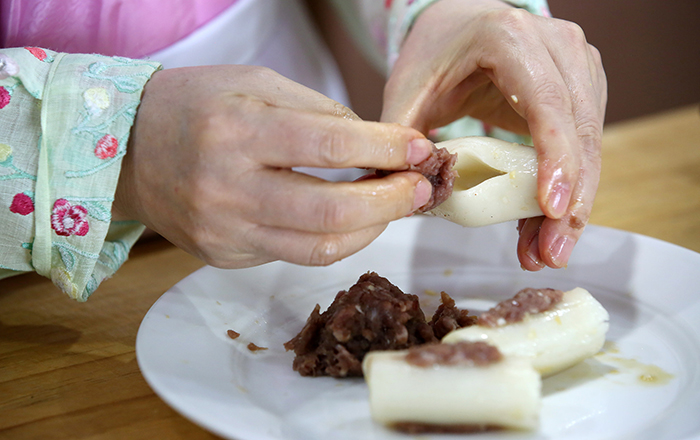
Stuff the rice cake with chopped beef, putting it into the cut slits. If the rice cake is hard, boil the pieces to make them tender.
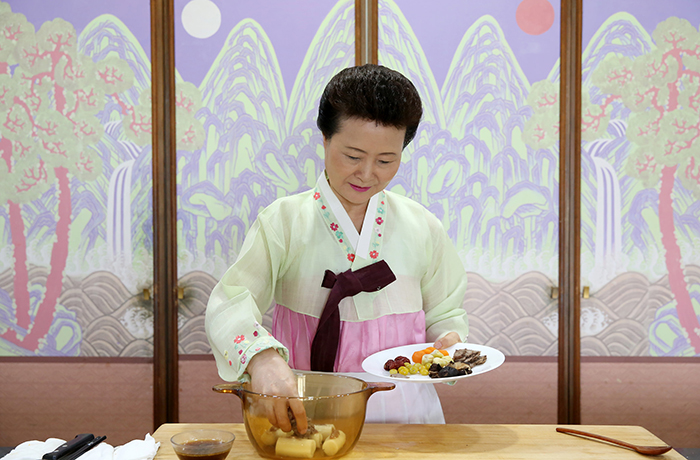
Mix the rice cake, jujube and marinade 2 together and heat it over medium heat for 13 minutes.
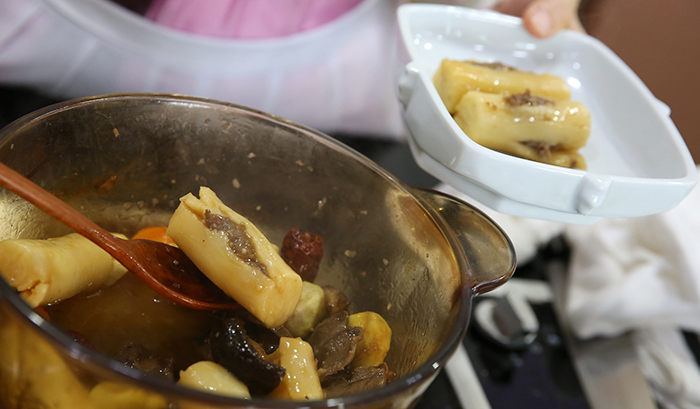
Mix in the ginkgo and pine nuts. Serve the dish on a plate with slices of egg white and yolk and the water parsley pancake as decoration. Make sure not to put the rice cake in at the start otherwise it could burst.